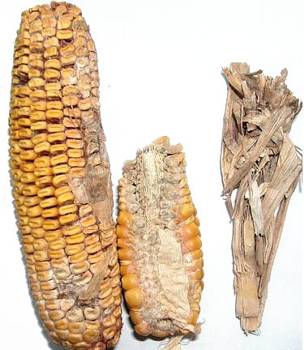Diseases
Nigrospora oryzae Petch. - Nigrospora Ear Rot or Cob Rot of Maize.
Systematic position.
Nigrospora Ear Rot or Cob Rot is caused by the fungus Nigrospora oryzae (=Basisporum gallarum); teleomorph Khuskia oryzae.Biological group.
Facultative parasite.Symptoms.
Causal agent infects maize seedlings and adult plants. The lower part of pedicle turns brown and softens; plants lodge and rot. In the following vegetation period, the first symptoms of the Nigrospora Ear Rot are shredding of pedicle and lower part of shanks, black spore masses are scattered in shredded pith of the cob and on the kernel tips. Later black abundant scurf develops on cob and on reproductive buds in leaf sheaths. Under strong disease development ears remain undeveloped and lightweight. Affected kernels are dull, slightly grayish, and undeveloped.Biology and morphology.
Fungus develops friable grayish mycelium located in groove of maize cob and between kernels. Conidiophores forming on mycelium are simple or irregularly branched (with septa), pale-olive, ventricose at the top. One spherical or elliptic conidium develops on the tops of conidiophores, initially translucent, and later becoming black with a thick border. Diameter of conidia is 12 to 15 microns. During maize vegetation period the conidia are spread by wind, rain, and insects (Angoumois grain moth). Conidia fall on weakened or dead parts of kernels and germinate, forming surface mycelium that attack neighboring tissues. The phase of cob maturing is the most vulnerable period for infection of maize. Fungal spreading in cob core inhibits kernel development. Conidia remain viable for a year on cobs, in cob core, and leaf sheaths and provide primary infection for the next season. The fungus can also be present on sown seed and on plant residues as mycelium and on the soil surface as spores.Distribution.
Nigrospora Ear Rot is widely distributed, but the extent of its prevalence varies greatly from year to year. The disease has been registered in Ukraine, Moldova, the North Caucasus, the Far East, Bashkortostan, Altai and Omsk Regions, and western regions of Georgia. High levels of Nigrospora Ear Rot have been observed in some years in the central part of the steppe and forest-steppe zones of Ukraine and Russia.Ecology.
Seedlings are infected under unfavorable spring conditions (temperature fluctuation, frost, drought, and damage from other diseases). Maximum disease development occurs during the cob maturing phase and is observed in years with wet weather and moderate air temperature. Nigrospora Ear Rot is found especially on later maize sowings and on fields with low levels of agriculture, on mechanically damaged plants, and also on fields that are harvest later. Optimal temperature for fungus growth is 20 to25 .C, but the fungus can develop under a wide range of temperatures (from 3 to 40.C). Incubation period after inoculation lasts 4 to 5 days in flowering stage and 5 to 7 days in milky stage.Economic significance.
N. orizae develops on maize, rice, and sorghum. Disease can be very harmful. Affected ears have no practical value, being quickly destroyed in storage. Infected kernels mold during germination, having reduced germinating capacity. Plantlets usually perish before emerging or, if plantlets develop, their growth is delayed. Maize kernels infected by Nigrospora Ear Rot are toxic. Protection measures consist of creating conditions favorable for plants to resist disease, i.e., the optimal time for sowing and harvesting, ploughing-in plant residues, seed dressing, using healthy seed material for sowing, and cultivation of resistant varieties.Reference citations:
Borovskaya M.F., Matichuk V.G. 1989. Diseases of maize. Technology of planning and maize and sorghum yield. Technologiya vozdeluvaniya i urozhai kukurusu i sorgo. Kishinev: Shtiintsa. 119-126 pp. (In Russian)Borovskaya M.F., Matichuk V.G. 1990. Diseases of maize. Kishinev: Shtiintsa. 132-138 pp. (In Russian)
Hawksworth D.L., Kirk P.M., Sutton B.C., Pegler D.M. 1995. Ainsworth & Bisby.s Dictionary of the Fungi. Kew: CAB International. 616 pp.
Kirimelashvili I.S., Dolidze M.I. 1969. Materials for studies of Nigrospora Ear Rot in Georgia. Reports of Institute of Plan Protection. Georgia: Tbilisi. V.21: 92-93. (In Russian)
Kulik T.A. 1955. Features of pathogenesis of Nigrospora Ear Rot of maize and substantiation of protection measures. Ph.D. Thesis. Karkhov State University. 18 pp. (In Russian)
Kulik T.A. 1956. Nigrospora Ear Rot of maize in Ukraine. Ukrainskii botanicheskii zhurnal 13(3): 87-91. (In Russian)
Nemlienko F.E. 1957. Diseases of maize. Moscow: Sel.khozgiz. 48-57 pp. (In Russian)
Nikolaeva N.F., Skripnyuk V.N. 1979. Diseases of maize in Stavropol. Territory and protection measures. New Protection Measures against Pests and Diseases of Maize. Collection of papers of All-Union Science-research Institute of Maize. 132-135 pp. (In Russian)
Peresypkin V.F. 1989. Agricultural phytopathology. Moscow: Agropromizdat. 480 pp. (In Russian)
Sibiryak L.A. 1961. Pests and diseases of maize in Bashkortostan. Proceedings of Bashkortostan agricultural institute: Reports of interuniversity scientific conference about planting problems and utilization of maize in Ural Region. Ufa. V. 10(1): 211-216. (In Russian)
Susidko P.I., Gritsenko G.V., Nemlienko F.E. 1975. Integrated system of measures for maize protection from pests, diseases and weeds. Moscow: Kolos. 47 pp. (In Russian)
Vinogradova N.I. 1960. Diseases of maize in steppe part and southern forest-steppe of western Siberia. Collection of reports of scientific conference of Siberian and Far Eastern universities and science-researched institutes. Omsk: Agricultural Institute. 182-186 pp. (In Russian)
© Gultyaeva E.I.


